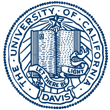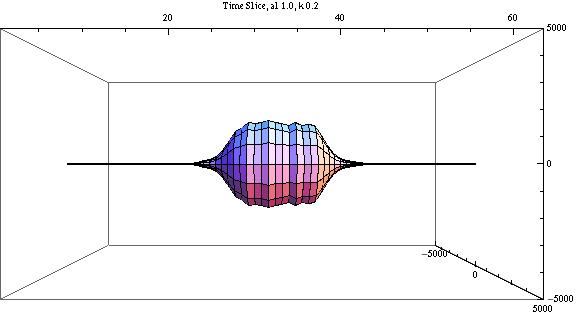
This REU program was funded through NSF PHY-0649297.


Students' names link to their final papers.
Condensed Matter Experiment
Granular materials, such as sandpiles, consist of a large number of macroscopic grains. Counterintuitively, a granular pile containing two types of grains tends to segregate under perturbations such as shaking or rotating. A first step in studying the segregation patterns produced is to identify the grain positions in a large number of piles. Justin Eldridge (Ohio State University; advisor Rena Zieve) designed a neural network algorithm to recognize hexagonal grains in digital images of a two-dimensional heap. The hexagons are detected by their green color and through their distances to other grains. By combining the neural network with a direct criterion for hexagons, Justin was able to locate over 95% of the hexagons correctly. He then began to construct heat maps showing where the hexagons tend to lie. The next goal is to relate the locations of the hexagons to the behavior of the heap, such as its stability against avalanches.
Kaitlyn Yoha (Duquesne University; advisor Dong Yu ) used a vapor-liquid-solid (VLS) method to grow PbS nanowires doped with Mn, a magnetic atom. Such wires may be useful in spintronics, where information is conveyed by flipping spins rather than by transporting charge, or for solar cells. Typically growing solid samples directly from a vapor is a slow process; to speed it up VLS uses a liquid droplet that rapidly absorbs the vapor, with the solid then grown from an initial seed within the droplet. Kaitlyn also worked on characterizing the samples through x-ray diffraction and electron paramagnetic resonance. Although Mn was present, there may be separate PbS and MnS phases rather than the desired single (Pb,Mn)S phase. Since the small quantities of nanowires made the characterization measurements difficult, Kaitlyn also explored ways to increase the yield, varying such growth parameters as time, temperature, and vapor pressure. A UCD student will continue the work during the school year, beginning with magnetic dichroism measurements to sort out the nanowire composition.
Justin Young (Otterbein College; advisor Rena Zieve) helped set up and carry out uniaxial pressure measurements on two novel superconductors. The first was CaFe2As2, which is superconducting under quasi-hydrostatic pressure. The irreproducibility of the results suggests that variations from purely hydrostatic pressure have a strong effect, making it interesting to study the opposite extreme of uniaxial pressure. Justin began by monitoring a magnetic transition near 175 Kelvin, which seems tied to the superconductivity. The transition did change some with pressure, but not in an easily understandable way. The research group plans further measurements of the high-temperature transition before searching for the superconducting phase. Justin's other sample was CeCoIn5. He set up a sample for uniaxial pressure along the crystal a-axis. Since this material tends to grow in platelets with the a-axis in the plane, Justin had to find the most promising bits of samples, x-ray them to determine crystal orientation, and polish them smooth. Just before he left, he detected the superconducting transition through magnetic susceptibility and tested the effects of applying uniaxial pressure.
Condensed Matter Theory
Brianna Dillon (Grove City College; advisor Richard Scalettar) studied the onset of collective behavior using spins on a two-dimensional grid. The spins orient randomly at high temperatures, but an interaction between neighboring spins brings about an overall alignment at low temperatures. Brianna also introduced vacancies, where certain spins were missing entirely. By eliminating some of the neighbor interactions, the vacancies shift the ordering to lower temperatures. The spin system can serve as a model of superfluidity in mixtures of 4He and 3He: a spin corresponds to the 4He "order parameter," which measures the fraction of superfluid atoms, at that location, while the vacancies correspond to the 3He portion of the mixture. Brianna mapped out a full phase diagram for the model. Most interestingly, she found a crossover from a second-order transition at relatively high temperatures to a first-order transition, identified by hysteresis, a the lowest temperatures.
Biological Physics
Alison Saunders (Reed College; advisor Daniel Cox) examined configurations of the protein CPEB. A protein consists of a chain of amino acids, folded into a pattern that often involves common structures such as helices. Although the normal structure for CPEB is known, a misfolded structure that may be involved in memory disorders cannot be determined experimentally. Knowing the alternate structure may be helpful in understanding how the misfolded protein acts. Alison examined one possible structure, a left-handed beta-helix, by arranging the known amino acid sequence for CPEB along the helix and evaluating how favorable the arrangement is through a scoring system. For example, certain amino acids are more energetically favorable on the inside of the helix, others on the outside; certain amino acid pairs that lie above each other on consecutive loops of the helix can form energetically favorable cross-links; and so on. Alison could vary the spacing of the amino acids along the helix to optimize these factors. She searched for low-energy configurations in part computationally and in part by hand. She then inserted particularly low-energy structures into a computationally expensive molecular dynamics simulation to predict how the structures develop in time. Those that change little are stable. By studying both CPEB and a related but simpler protein, Alison found a stable left-handed beta-helix configuration for part of CPEB.

General Relativity
Maria Baryakhtar (Harvard University; advisor Steve Carlip) did Causal Dynamical Triangulation (CDT) simulations. CDT involves calculations of how the geometry of space evolves. In order to do numerical work, spacetime is approximated by simplices (i.e., triangular pyramids). After defining certain steps that transform one triangulation into another, the simulations use a Monte Carlo technique to sample different possible triangulations. In certain cases, the calculations show a transition between a single connected space, and an unphysical series of decoupled subspaces that evolve independently. Maria found that varying the relative scale factor between time and space dimensions affects the location of the transition. Better understanding the influence of this parameter is needed to determine how well CDT agrees with physical fluctuations of spacetime.
Elementary Particle Experiment
The LUX collaboration hope to detect dark matter through its interactions with liquid xenon. To shield the xenon from other, less exotic interactions, the detector will be placed at the bottom of a mine shaft and surrounded by hundreds of tons of water. Energetic particles that may produce signals in the xenon will first pass through the water bath. Since the speed of light is reduced in water, the particles will move faster than the speed of light and emit Cherenkov radiation. Correlating bursts of Cherenkov radiation to interactions in the xenon will help identify spurious events. However, the water may also introduce noise through bubbles where submerged photomultiplier tubes heat the water. Angela Galvez (American River College; advisors Bob Svoboda and Mani Tripathi) investigated how bubbles will affect the detectors. She searched for ways to simulate the experimental situation, including heating water, using liquid nitrogen which naturally boils at room temperature, and slowly blowing bubbles through a straw. During the school year she will continue to work on how the electronics react to bubbling.
One of the goals of the Long Baseline Experiment at the Deep Underground Science and Engineering Laboratory (DUSEL) is to observe whether neutrino oscillations have a certain asymmetry known as charge-parity (CP) violation. Like the LUX experiment, the measurement involves Cherenkov radiation in a tank of water. Joshua Gevirtz (Ball State University; advisor Bob Svoboda) considered two sources of Cherenkov radiation, one that retains key information on the original neutrino and one that does not. The hope was to find difference in the energy spectra of the radiation from the two sources, so that detectors could be tuned to an energy range that maximized the distinction between them. Unfortunately, Josh's calculation results showed no significant differences in the energy spectra, so some other tool will have to be used to distinguish the two event types.
Nuclear Physics
The Relativistic Heavy Ion Collider at Brookhaven National Laboratory achieves huge energies, comparable to those a few seconds after the Big Bang, by colliding gold atoms. A recent suggestion to increase the energy yet further by replacing the gold with uranium. Uranium is heavier, but even more importantly, its nucleus is ellipsoidal. Depending on the orientation of the uranium nuclei, the collision energy can be enhanced nearly 40% over that of gold-gold collisions or decreased by up to 10%. Chris Flores (St. Mary's College, Texas; advisors Manuel Calderon de la Barca Sanchez and Daniel Cebra) examined this scheme by calculating energy for the most energetic 5% of the collisions. Sadly, he found little difference between the two species. Without a way to orient the nuclei in the beam, the most energy-enhancing arrangement is so unlikely to occur that it would have negligible effect on the experimental results. If Chris's work holds up under careful examination, the proposed switch from gold to uranium will not take place.
Astrophysics
Although on a very large scale the universe "looks the same" in all directions, at a more detailed level mass clumps together, forming stars, galaxies, and galaxy clusters. Galaxy clusters are often detected as particularly bright spots, and then confirmed by verifying that multiple galaxies in the area have similar redshift. The redshift determines how far away from us the galaxies are. A different technique is to look for massive areas that distort light passing by them through weak gravitational lensing. Comparing properties of clusters detected by different methods can give additional information on how the clusters develop. Aaron Nowack (Sierra College; advisor Dave Wittman) extracted the mass of galaxy clusters identified through gravitational lensing. He used a variety of techniques to improve data quality from the Deep Lens Survey beyond that of a single image, and began work on modeling and fitting to assign masses. Aaron is continuing the project into the school year to achieve masses that can be confidently compared with those of optically detected clusters.
In recent years various planets have been discovered orbiting around stars other than our sun. Generally a planet makes its star appear slightly brighter than it otherwise would, since we detect both light radiated directly from the star and also light that reaches us via the planet. During a primary eclipse, the planet passes in front of the star, blocking some of its light. During a secondary eclipse, the planet moves behind the star, so that the only light we detect comes directly from the star. While harder to detect, secondary eclipses yield information on the amount of light reflected from the planet and hence on its temperature. Nathaniel Rodriguez (University of Redlands; advisor Matt Richter ) investigated what hardware (telescopes and detectors) are needed to observe secondary eclipses. Using test data from a wide-field survey telescope, he determined that the telescope was more than adequate for the measurements. Part of the signal extraction involves normalizing how background stars appear in different images, but Nathaniel found that with 150 to 200 stars the noise becomes limited by other factors. The field of view on the survey telescope contained several times as many stars as needed, suggesting that such measurements could be continued on smaller telescopes that are less in demand. The next step is finding potential planets, ideally several that could be observed simultaneously, and obtaining telescope time for the work. Nathaniel was able to continue his project into the schoolyear and in June 2010 travelled to Hawaii to participate in observations.